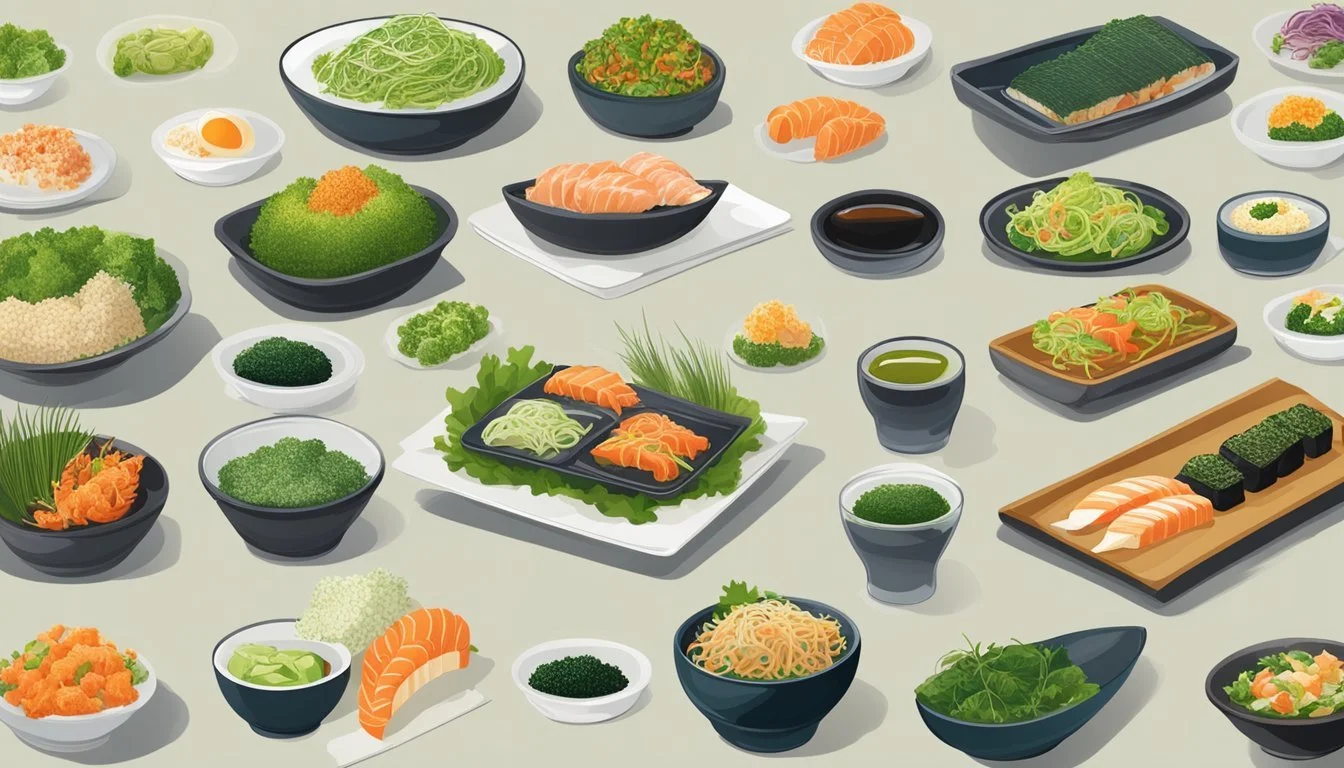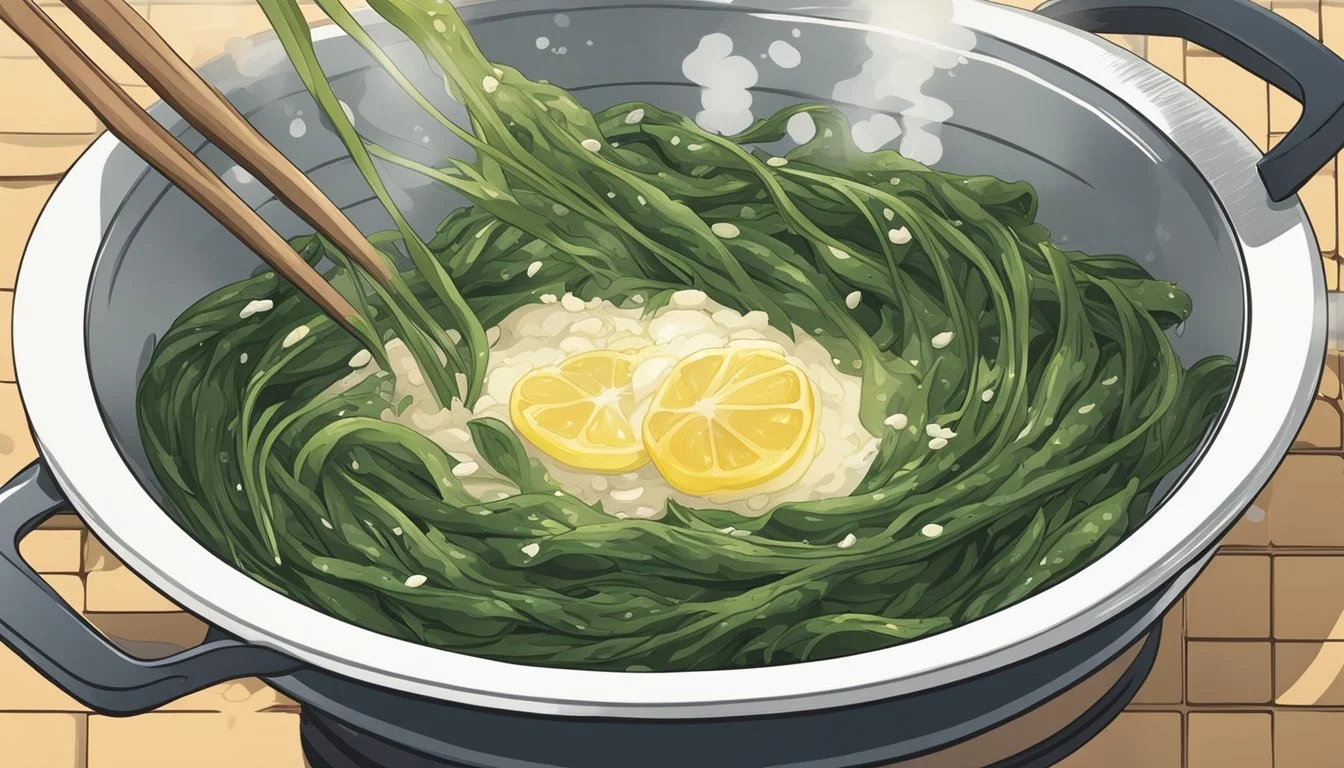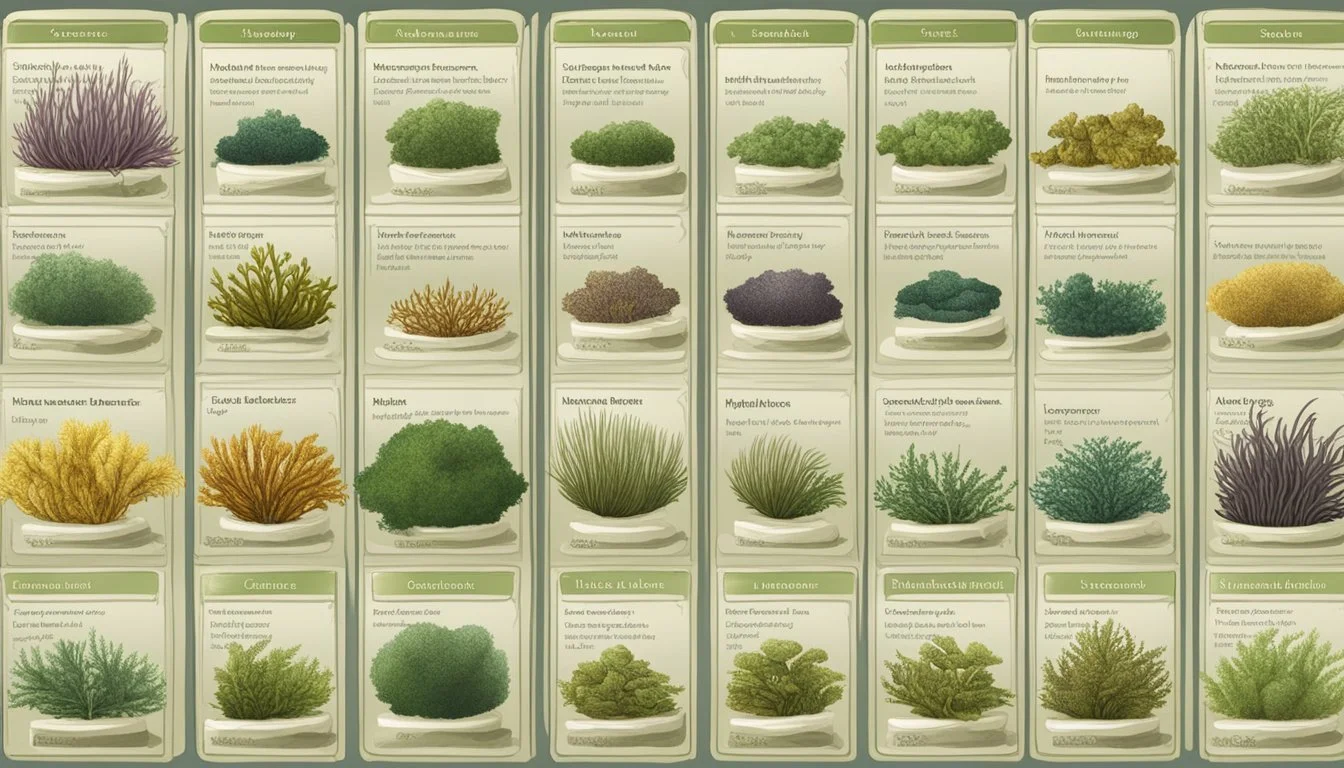Arame Substitutes
Best Alternatives for Cooking and Nutrition
Navigating the world of sea vegetables can be daunting, especially when trying to find the perfect substitute for arame. Arame is a popular seaweed in Japanese cuisine, known for its mild flavor and nutritional benefits. For those who might not have arame on hand or are looking for something slightly different, there are various seaweed substitutes to explore.
Hijiki is often recommended as a top substitute for arame due to its similar texture and umami-rich taste. Though slightly less delicate and not as mild, it offers a robust alternative. Kelp, particularly kombu, is another excellent option. It shares a similar taste and texture profile, making it ideal for recipes that traditionally use arame.
For those seeking other alternatives, wakame and nori can also be suitable choices depending on the dish. Wakame offers a slightly different flavor while still providing the desired texture. Nori, commonly used in sushi, can be a versatile substitute for various culinary applications.
Understanding Arame
Arame, a type of edible seaweed, is highly valued in Japanese cuisine and is known for its unique flavor and nutritional benefits. Detailed insights into its origins, uses, nutritional qualities, and taste characteristics are essential for understanding its role in culinary applications.
Origins and Culinary Uses
Arame originates from the cold waters around Japan, where it has been harvested and used for centuries. This sea vegetable is often found in traditional Japanese dishes such as soups, salads, and stir-fries. Before use, arame is typically soaked in water to rehydrate, enhancing its texture and making it easier to cook with. In addition to its culinary uses, arame also serves as a natural thickening agent in dishes.
Nutritional Profile
Arame is packed with nutritional benefits, making it a healthy addition to any diet. It is exceptionally high in iodine, which is crucial for thyroid health. A 10-gram serving provides around 4,000 mcg of iodine, about 26 times the daily recommended value. Arame also contains significant amounts of fiber, vitamins such as riboflavin, and essential minerals like potassium and sodium. These nutrients contribute to overall health, supporting functions such as blood pressure regulation and cellular health.
Distinctive Flavor and Texture
The flavor of arame is mild, slightly sweet, and packed with umami, making it a versatile ingredient in various dishes. Its texture is tender yet slightly firm, providing a pleasant mouthfeel that contrasts well with other ingredients. When cooked, its thin, dark strands retain their form, adding visual intrigue to meals. Unlike some other seaweeds, arame has a delicate taste that does not overpower other flavors in a dish, making it preferred for enhancing without overwhelming.
These attributes of arame highlight its versatility and nutritional value, making it an invaluable sea vegetable in both traditional and modern culinary contexts.
Health Benefits of Arame
Arame seaweed is an impressive source of essential nutrients that support various aspects of health. It is particularly noted for its high mineral content and its potential benefits for weight management and blood pressure regulation.
Rich in Minerals
Arame is a nutrient-dense food, particularly rich in minerals such as calcium, iodine, and iron.
Calcium is crucial for bone health and helps in maintaining strong teeth. Regular consumption of arame can contribute to meeting daily calcium requirements.
Iodine is essential for thyroid function, which regulates metabolism. Arame’s high iodine content supports healthy thyroid hormones, aiding in metabolic processes.
Iron in arame helps in the formation of hemoglobin, the protein in red blood cells that carries oxygen throughout the body. This can improve energy levels and combat iron-deficiency anemia.
Contribution to Weight Loss
Arame's fiber content is significant in promoting weight loss. Dietary fiber increases feelings of fullness, which can help reduce overall calorie intake.
Fiber also aids in digestion, helping to maintain regular bowel movements. This can prevent constipation and improve gut health.
Moreover, the low-calorie nature of arame makes it a suitable addition to a weight-loss diet. Replacing higher-calorie foods with nutrient-dense arame can support a caloric deficit, which is necessary for weight loss.
Blood Pressure Regulation
Arame contains nutrients that may help regulate blood pressure.
Potassium, found in arame, helps balance sodium levels in the body. This balance is critical in maintaining normal blood pressure levels.
Additionally, the presence of omega-3 fatty acids in arame can contribute to heart health by reducing inflammation and improving blood vessel function.
Regular consumption of arame may support cardiovascular health through these mechanisms, aiding in the management of blood pressure levels naturally.
The magnesium present in arame also plays a role in relaxation of blood vessels, further contributing to blood pressure regulation and overall cardiovascular health.
By incorporating arame into a balanced diet, individuals can leverage its health benefits in various aspects of wellness.
Common Arame Culinary Applications
Arame, a mildly sweet and delicate seaweed, serves as a versatile ingredient in various culinary contexts. It is often used in both traditional Japanese dishes and modern culinary creations, complementing a wide range of flavors and textures.
Traditional Japanese Dishes
In traditional Japanese cuisine, arame frequently finds its place in salads and side dishes. Salads incorporating arame are typically paired with vegetables like carrots, cucumbers, and radishes, offering a refreshing and light addition. For classic side dishes, arame is sautéed with root vegetables such as burdock and lotus root. This combination adds a deep umami flavor profile, which can be further enhanced by using soy sauce or mirin. Additionally, arame can be found in miso soups, where it contributes a subtle sweetness and enriches the broth’s texture.
Modern Culinary Creations
Modern chefs have integrated arame into a variety of contemporary dishes. Arame and roasted squash salads are popular for their contrasting colors and textures, mixing the dark seaweed with the bright, sweet tones of butternut or kabocha squash. Arame also works well in grain bowls, combined with ingredients like quinoa, toasted seeds, and fresh greens to create nutrient-dense meals. Fusion dishes where arame is used for its unique texture and mild flavor include wraps, tapas, and sushi rolls. By soaking and rehydrating arame, it can be effortlessly added to pasta dishes, risottos, or even as a topping for pizzas.
These creative applications showcase arame's adaptability across diverse cuisines, from traditional Japanese meals to inventive modern dishes.
Selecting Arame Substitutes
When choosing an arame substitute, it's crucial to consider flavor, texture, and nutritional content. Each of these factors will help you find the best replacement.
Taste and Flavor Considerations
Hijiki is an excellent substitute for arame due to its strong umami and mushroom-like flavors. It provides a robust taste that can stand up in various dishes. Wakame has a milder, slightly sweet flavor that also works well but is less intense than hijiki.
Kombu and nori are other viable options. While kombu offers a deep, rich umami, nori gives a milder, more neutral taste. Each seaweed brings a distinctive flavor profile, making them versatile substitutes for arame.
Textural Similarity
Hijiki offers a slightly thicker and more robust texture compared to arame. It's less delicate but provides a satisfying bite. Wakame has a softer, more slippery texture, which can be perfect for salads and soups.
Nori and cucumber wraps provide unique textural experiences. Nori has a delicate, papery texture suitable for sushi and wraps. Thinly sliced cucumbers offer a crisp texture, ideal for fresh, crunchy dishes. Each substitute offers a different mouthfeel, suiting various culinary needs.
Nutritional Comparisons
Hijiki is rich in minerals and fiber but can have high levels of inorganic arsenic. This makes it a nutritious, yet controversial option. Wakame is packed with vitamins (A, C, E, and K), minerals, and iodine, providing a well-rounded nutritional profile.
Kombu offers significant amounts of iodine, supporting thyroid health. Meanwhile, nori contains iron, calcium, and vitamins A and C. Each substitute provides a mix of nutrients, ensuring your dish maintains its health benefits.
Selecting the best arame substitute involves balancing flavor, texture, and nutrition to match your needs and preferences.
Top Substitutes for Arame
When looking to replace arame in recipes, there are several seaweed options that can provide similar flavors and nutritional benefits. Here are four of the best substitutes: kombu, wakame, hijiki, and nori.
Kombu
Kombu is a type of kelp widely used in Japanese cuisine, particularly for making dashi, a foundational broth for miso soup. It has a rich umami flavor, making it an excellent arame substitute if depth of flavor is needed.
Kombu can be found in dried sheets or strips. It should be soaked in water before use to soften it. It's particularly well-suited for soups, stews, and stocks. Kombu is also rich in iodine, calcium, and magnesium, adding nutritional value to dishes. When cooking with kombu, be mindful of its tendency to become slimy if cooked too long.
Wakame
Wakame is another sea vegetable common in Japanese dishes, such as seaweed salads and miso soup. Known for its mild, slightly sweet flavor, wakame is a versatile substitute for arame.
Wakame needs to be rehydrated in water, which takes about 20 minutes. Once rehydrated, it triples in size, becoming tender and ready to use. Its soft texture is ideal for salads and soups. Wakame is also high in essential nutrients like folate, magnesium, and manganese, making it a healthy addition to meals.
Hijiki
Hijiki is a darker seaweed that has a stronger, more pronounced flavor compared to arame. It's a good choice when a robust, earthy taste is desired. Like arame, hijiki requires soaking prior to use.
It is commonly used in salads and side dishes. Though flavorful, hijiki has been flagged for its high levels of inorganic arsenic. Due to this, some may prefer to use it sparingly or opt for other seaweeds. Despite the caution, it remains a nutrient-dense substitute rich in fiber and minerals.
Nori
Nori is best known for its use in sushi rolls, providing a slightly salty, crisp texture. While it differs from arame in texture and flavor, it can still serve as a good substitute in specific recipes.
Nori sheets can be crumbled and added to salads or soups, offering a different yet complementary seaweed flavor. They are also packed with vitamins A, B, and C, along with protein. Nori is versatile but may not work in recipes that require a similar texture to arame. For those uses, other seaweeds like kombu or wakame might be more suitable.
By considering these substitutes, one can effectively replace arame in various culinary applications while maintaining the desired flavor and nutritional profile.
Innovative Uses of Seaweed Substitutes
Seaweed substitutes offer diverse culinary applications, enhancing dishes with unique textures and flavors. In addition to their nutritional benefits, these substitutes can be creatively used in salads, soups, garnishes, seasonings, and main dishes.
In Salads and Soups
Seaweed substitutes like wakame, hijiki, and kelp integrate seamlessly into both salads and soups. Their unique textures and vibrant flavors elevate simple recipes.
In salads, thin strips of wakame or kelp add a slightly crunchy texture and briny taste. Hijiki, darker and more robust, can bring a distinct umami flavor, perfect for more hearty salads.
In soups, these sea vegetables contribute depth and richness. Japanese miso soup often utilizes wakame, while Korean soups might incorporate kelp for its mineral-rich profile.
As Garnishes and Seasonings
Arame and other seaweed substitutes can function excellently as garnishes and seasonings. When dried and crumbled, nori or kombu can be sprinkled over dishes to add a subtle umami flavor.
In Japanese cuisine, dried seaweed flakes, known as furikake, are common seasonings for rice and other dishes. They provide a combination of sweetness, saltiness, and crunch, enhancing the overall taste profile.
For a fresh garnish, thinly sliced cucumber wraps or rice sheets can replace traditional seaweed, bringing both visual appeal and a new texture to the dish.
In Main Dishes
Seaweed substitutes can play significant roles in main dishes, especially in Asian inspired cuisine. Rice sheets or smoked salmon sheets can be used to make sushi, giving a new twist to traditional recipes.
In stir-fries, kelp or wakame can be used to introduce briny flavors and a chewy texture. Dishes like pasta or noodle bowls can benefit from the addition of seaweed sub stitutes, enhancing the umami content and providing extra nutrients.
Integrating these seaweed alternatives allows for inventive culinary creations, transforming simple meals into memorable dining experiences.
Culinary Techniques with Seaweed
Seaweed adds unique flavors and textures to dishes, from rehydrating for optimal use to incorporating into various recipes and experimenting with creative pairings.
Rehydrating Dry Seaweed
Dry seaweed requires proper rehydration to bring out its best culinary qualities. To rehydrate, immerse it in cold water for 10-15 minutes, ensuring it expands and softens. For a quicker method, boiling water can be used, reducing rehydration time to about 5 minutes.
When rehydrating, be aware of the significant volume increase, often tripling in size. This is crucial for dishes like stews and casseroles where the correct proportion ensures balanced flavors. Proper rehydration also ensures the seaweed retains its nutrients, such as fiber and minerals.
Incorporating into Cooked Dishes
Seaweed can elevate the flavor profile of many cooked dishes. In stews and casseroles, it adds a deep umami taste that complements other ingredients. Arame, for instance, pairs well with mushrooms and root vegetables in a hearty stew.
It can also be included in omelets, where its umami enhances the dish's overall flavor. Adding seaweed to rice, either mixed directly or infused in the cooking water, brings a subtle depth to plain rice. Using it in miso soup or broths infuses the liquid with rich flavors, perfect for a comforting meal.
Creative Pairings and Combinations
Experimenting with seaweed in diverse combinations can yield delightful results. Combining seaweed with ube (purple yam) creates visually striking and flavorful dishes. Arame's mild flavor blends seamlessly with the natural sweetness of ube in both savory and sweet preparations.
For a modern twist, use seaweed with rice paper in wraps, providing a unique texture contrast. Seaweed's umami can be amplified with a touch of MSG, balancing bold flavors in complex recipes.
Chefs can also explore seaweed in salads, where its briny taste pairs well with citrus dressings and fresh vegetables. Asian-inspired dishes can benefit from combining seaweed with traditional seasonings like soy sauce, ginger, and sesame oil.
Nutritional Aspects of Seaweed Substitutes
Seaweed substitutes offer a wide range of nutritional benefits comparable to traditional seaweed. These benefits include essential minerals, vitamins, and dietary fiber, making them valuable alternatives for various dietary needs.
Mineral Content
Seaweed substitutes such as wakame and hijiki are notable for their mineral content. Potassium, magnesium, calcium, and iron are commonly found in these alternatives.
Wakame: Rich in calcium, magnesium, and iron, aiding in bone health and muscle function.
Hijiki: Known for its high calcium content, promoting strong bones and teeth.
Rice Paper: Although not a seaweed, it offers modest amounts of minerals, primarily when fortified.
These substitutes can support essential body functions and contribute to overall well-being when included in a balanced diet.
Vitamin Enrichment
Certain seaweed substitutes are enriched with vitamins that are vital for various bodily functions, like boosting the immune system and maintaining skin health.
Wakame: High in vitamins A, C, E, and K. Vitamin A supports vision, vitamin C enhances immunity, and vitamin K is crucial for blood clotting.
Cucumber wraps: Though not high in vitamins compared to traditional seaweed, they offer vitamin K, which is important for bone health.
Smoked Salmon Sheets: Provide vitamins D and B12, supporting bone health and energy metabolism.
These options can help meet daily vitamin requirements, especially for those looking to mimic the nutritional profile of seaweed.
Dietary Fiber
Dietary fiber is fundamental for digestive health, and seaweed substitutes can be good sources of this nutrient.
Wakame: Contains soluble fiber that aids in digestion and helps maintain a healthy gut microbiome.
Hijiki: Offers a chewy texture and substantial fiber content, promoting satiety and digestive health.
Rice Paper: While not as rich in fiber as seaweed, it can still provide a minimal amount of dietary fiber to aid in digestion when incorporated into a balanced diet.
Including fiber-rich substitutes helps in managing weight, controlling blood sugar levels, and improving overall digestive health.
These nutritional aspects make seaweed substitutes valuable for those looking to maintain or enhance their dietary intake of essential minerals, vitamins, and fiber.
Environmental and Dietary Considerations
Choosing substitutes for arame involves assessing both the environmental impact and dietary benefits of different options. The following sections explore sustainable seafood choices and address key dietary concerns such as allergies and nutritional content.
Sustainable Seafood Choices
Seaweed and algae are popular arame substitutes. They are not only rich in dietary fiber and protein but also have a lower environmental impact compared to traditional seafood. Hijiki, for example, is a less delicate, nutrient-dense seaweed with a mushroom-like flavor. Green algae options, including spirulina, offer abundant protein and minerals.
Sustainable harvesting methods are crucial. Overexploitation of marine resources can lead to problems like seal habitat destruction and water pollution. Edible seaweed farming minimizes these risks because it typically requires fewer resources and may even help reduce ocean acidification by absorbing CO2.
Allergy and Dietary Restrictions
Edible seaweeds like hijiki provide a nutritious alternative for those with seafood allergies or dietary restrictions. They are generally low in saturated fats and contain essential nutrients like iodine, iron, and calcium. For people allergic to shellfish, seaweed offers a safe and healthy option.
However, it's essential to monitor for contaminants. Seaweeds can sometimes contain trace amounts of lead and arsenic. Therefore, sourcing seaweed from reputable suppliers who test for these substances is crucial. For those focusing on a high-fiber diet, seaweeds offer substantial dietary fiber, promoting digestive health without the risks posed by more allergenic seafoods.
Exploring Regional Seaweed Varieties
Regional seaweed varieties offer unique flavors and nutrients, deeply influencing local cuisines and dietary practices. Key varieties can be found across Japan and Asia, with unique adaptations emerging in Western diets.
Seaweeds in Japanese Cuisine
Japan is renowned for its diverse seaweed usage. Wakame and Kombu are staples. Wakame, often used in soups and salads, provides a subtle sweetness and tender texture. Kombu, on the other hand, is essential to making dashi, a foundational broth in Japanese cooking. Nori is commonly used for sushi rolls, including California rolls. Each type enhances distinct dishes with its specific texture and taste, making them integral to Japanese cuisine.
Varieties across Asia
Asian countries have their own distinctive seaweeds. In Korean cuisine, Kim (similar to nori) is used in wraps and snacks, offering a crispy texture. Hijiki is popular in Japan for its earthy flavor and is often simmered with vegetables. Kelp noodles, a popular alternative in both Korean and Chinese dishes, are favored for their crunchy texture and minimal calories. Each variety brings specific health benefits and unique flavors, enriching regional diets.
Western Adaptations of Seaweed
Western cooking has embraced seaweed in creative ways. Kelp noodles are increasingly popular in gluten-free diets. Nori is not limited to sushi but is also used in wraps and salads. In California, seaweed is often incorporated into contemporary dishes like seaweed salads and rice bowls. Such adaptations highlight seaweed's versatility and its growing influence beyond traditional Asian cuisines.












